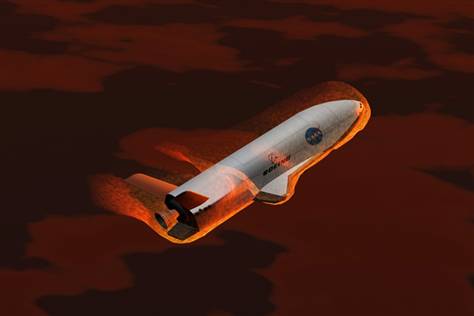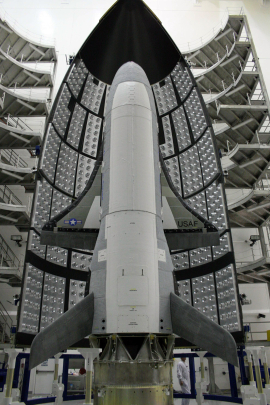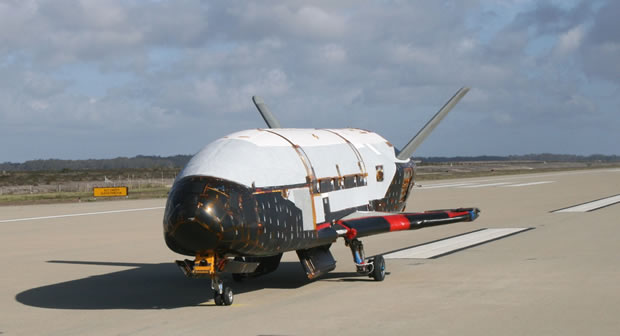"Today's landing culminates a successful mission based on close teamwork between the 30th Space Wing, Boeing and the Air Force Rapid Capabilities Office," said Lt. Col. Troy Giese, X-37B program manager from the AFRCO, which oversaw the mission. "We are very pleased that the program completed all the on-orbit objectives for the first mission."
In all, the X-37B space plane spent more than 220 days in orbit. Air Force officials said earlier this week that the X-37B could land anytime between Friday and Monday.
The Air Force has kept the exact nature and cost of the X-37B's secretive mission a closely guarded secret, but some analysts and skywatchers have speculated that the spacecraft served as an unmanned orbital spy platform.
Robot space drone's long flight
The Air Force launched the robot space plane atop an equally unmanned Atlas 5 rocket on April 22. Since then, the spacecraft has orbited Earth, at times tracked by meticulous skywatchers who first spotted the spacecraft in space using telescopes, then noticed its apparent manuevers to change orbits. [Video of the X-37B in space]
"This is a historical first, not only for Vandenberg Air Force Base, but for the Air Force and our nation to receive a recoverable spacecraft here and really take a step forward in advancing unmanned space flight," 30th Space Wing commander Col. Richard Boltz said in a statement issued before the landing.
The X-37B space drone is robotic winged spacecraft that looks in many ways like a miniature space shuttle. It was built by Boeing's Phantom Works Division in Seal Beach, Calif., and can fly long, extended missions because of its solar array power system, which allows it to stay in orbit for up to 270 days, Air Force officials have said.
Originally, NASA used the X-37B space plane as an experimental test bed until funding for the project ran out in 2004. The vehicle then passed to the Defense Advanced Research Projects Agency and was ultimately turned over to the Air Force in 2006.

An artist's illustration of the robotic X-37B space plane
during re-entry through Earth's atmosphere. |
|
X-37B's mystery mission
Air Force officials have said the X-37B Orbital Test Vehicle 1 is being used to demonstrate and test guidance, navigation and control systems, as well as evaluate autonomous landing techniques for winged spacecraft.
Details about any experimental payloads on the spacecraft are classified, Air Force officials have said.
Before the April launch of the Orbital Test Vehicle 1 flight, Gary Payton, Air Force deputy undersecretary of space programs, said that the X-37B is not a space weapon.
"I don't know how this could be called a weaponization of space," Payton told reporters at the time. "Fundamentally, it's just an updated version of the space shuttle kinds of activities in space."
But some facts about the X-37B spacecraft are well known.
For example, the spacecraft has two wings, a payload bay about the size of a pickup truck bed and black heat-resistant tiles to withstand the searing hot temperatures of atmospheric re-entry. |
This SPACE.com graphic of the X-37B depicts the characteristics and capabilities of the unmanned space plane.
The X-37B is about 29 feet (9 meters) long and has a wingspan of just over 14 feet (4 meters) across. It stands just over 9.5 feet (3 meters) tall and weighs nearly 11,000 pounds (about 5,000 kg).
The X-37B launches like a rocket and glides back to Earth like NASA's space shuttles, but instead of a single tail fin at the rear, the X-37B has two stabilizers, called "ruddervators," sprouting up in a "V" shape.
The vehicle was also equipped with a destruct mechanism, so Air Force officials could destroy it by remote control if it veered off course while gliding over the Pacific Ocean toward the Vandenberg Air Force Base.
Robot space plane's return
To prepare for the mini-shuttle's landing, a huge team of workers had to replace some 658 steel discs along the along the centerline of Vandenberg 15,000-foot runway because the older ones could have posed a hazard to the X-37B vehicle's tires, according to the Santa Maria Times newspaper.
The Air Force has already ordered a second X-37B, the Orbital Test Vehicle 2, which is slated to launch on another test flight sometime in the spring of 2011.
But for now, Air Force officials said they were ecstatic to see the successful return of the first X-37B spacecraft.
"With it being such a unique mission for the base, it is exciting to be a part of this historic landing," said Capt. Dariusz Wudarzewski, 2nd ROPS range operations commander. "For how long we have been working on it, I think everyone is really excited to see it culminate."
http://www.msnbc.msn.com/id/40491145/40492239
~~~~~~~~~~~~~~~~~~~~~~~~~~~~~~~~~~~
EDITOR'S NOTE: Here's an article which was published when the X-37B launch seven months ago. Notice the man standing next to the engine in the bottom right of the first picture, which give one a good refererence point that shows the size of the spacecraft:
 X-37B on the half shell -- (note the man lower right) X-37B on the half shell -- (note the man lower right). |
|
Air Force launches X-37B space plane
by Lance Whitney
CNET
With the launch Thursday of the X-37B spacecraft aboard an Atlas V rocket, the U.S. Air Force is taking a page from NASA's space shuttle program.
Looking somewhat like a traditional shuttle but at roughly one-quarter the size, the unmanned X-37B Orbital Test Vehicle took off for its maiden space voyage from Cape Canaveral in Florida and reached a low earth orbit late in the day. The X-37B is intended to serve as a platform for experiments and to offer insights on transporting satellite sensors and other equipment to and from space.
"If these technologies on the vehicle prove to be as good as we estimate, it will make our access to space more responsive, perhaps cheaper, and push us in the vector toward being able to react to warfighter needs more quickly," said Gary Payton, the Air Force deputy undersecretary for space programs, in a statement on the Air Force Web site.
Does that cryptic reference to "warfighter needs" signal the dawn of a new era of space weaponry? That probably remains some distance off in the future. The Pentagon is still in the very early days, for instance, of sorting out how to use directed-energy gear such as its lone Airborne Laser prototype. And certainly there are plenty of non-weaponized resources for the military in orbit, such as GPS and reconnaissance satellites, that a space plane could service.
As part of this initial mission, the Air Force will evaluate the X-37B's guidance, navigation, thermal protection, and unmanned operations in orbit, re-entry, and landing. It will function in space like other satellites, with operators on Earth monitoring its travels. Eventually, the Air Force will tell the space plane to head home. |
"Upon being given the command to return to Earth, the X-37B will automatically descend through the atmosphere and land on the designated runway. There is no one on the ground with a joystick flying it," said Lt. Col. Troy Giese, the X-37B systems program director, in a statement.

The X-37B Orbital Test Vehicle on the runway. |
|
Though the 11,000-pound vehicle--about 29 feet long, with a wingspan of just under 15 feet--is designed to stay in orbit for 270 days, the exact duration of its first flight hasn't been revealed.
Upon completing its first mission, the Boeing-built X-37B is due to touch down at Vandenberg Air Force Base in California.
The resemblance to the space shuttle isn't surprising. The X-37, in fact, was originally a NASA program, with roots in the space agency's lifting-body research, that ran from 1999 to 2004. That effort was intended to help in the design and development of a new Orbital Space Plane that would serve as a transport and rescue vehicle for crews at the International Space Station.
With NASA's fleet of space shuttles due to be retired later this year, the Air Force has been searching for a new class of vehicles to take over the role of reusable space plane. But the X-37B has a ways to go before it's fully fledged.
|
"There is much to learn in the first few flights on the technologies used on this vehicle, how quickly it can be readied for a re-flight, and on the operational utility," David Hamilton, director of the Air Force Rapid Capabilities Office, said in a statement. "We have started discussions with Air Force Space Command [officials] to plan for the possibility for transition to an operational capability, but the system first must prove its utility and cost effectiveness during the test program."
http://news.cnet.com/8301-13639_3-20003260-42.html
|